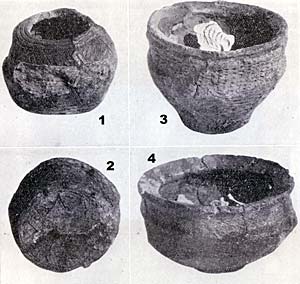By Alex Gibson at Prehistoric Ceramics Research Group
Pigmy Cups, Incense Cups, Biconical Cups, Aldbourne Cups, call them what you will, are a well-known component of the British Bronze Age grave furniture. Their perceived functions are, however, speculative. The Incense Cup interpretation of the early Wessex Antiquarians was deemed to have ‘nothing to recommend it’ by Abercromby in his pioneering corpus of 1912. Earlier, in his British Barrows of 1877, Canon Greenwell, not a great excavator, but ahead of his time in ceramic studies, listed the various past or contemporary interpretations of these vessels and concluded that none were entirely satisfactory. This conclusion remains valid. Interpretations ranging from drinking cups to lamps to burners of narcotic substances have graced the literature and the problem is that no single interpretation seems to work for every pot. Fenestrated Wall cups could not have held liquid but could have acted as lamps, particularly if beeswax was used. Multi-perforated cups such as Grape Cups or Biconical Cups could not have held liquid and one assumes that as the perforations were very much an essential part of the grammar of these types, then they were deliberate and functional. Incense or narcotic substances could indeed have been burnt in all these types but is there any direct evidence for it? One problem is that the cups of various types all have their own specific grammar and this suggests that they therefore may well have been designed for different uses. We may be wrong in trying to find the unifying function on such a typologically diverse set of vessels. It would be like classifying some Food Vessels, Beakers and Collared Urns together just because they tend to be under 30cm high. With the larger vessels we can see some very clear traditions yet the smaller vessels get grouped together simply because they are small.
 With this in mind, a programme of absorbed residue analysis was undertaken on some 25 cups from England, Scotland and Wales at the Department of Archaeological Sciences of the University Bradford. These samples were subject to Gas Chromatography (GC) and, if a possible signature was detected, by Gas Chromatography-Mass Spectometry (GC-MS). Both long-standing museum exhibits and very recently excavated examples were analysed but were generally unified by their failure to produce any tell-tale traces of former contents. A vessel from Whitford, Flintshire produced some possible traces of beeswax but these traces were too degraded to allow a positive identification. Other possible signatures might as easily have been the result of soil bacteria or recent accidental contamination. In short, those analysed do not seem to have been used.
With this in mind, a programme of absorbed residue analysis was undertaken on some 25 cups from England, Scotland and Wales at the Department of Archaeological Sciences of the University Bradford. These samples were subject to Gas Chromatography (GC) and, if a possible signature was detected, by Gas Chromatography-Mass Spectometry (GC-MS). Both long-standing museum exhibits and very recently excavated examples were analysed but were generally unified by their failure to produce any tell-tale traces of former contents. A vessel from Whitford, Flintshire produced some possible traces of beeswax but these traces were too degraded to allow a positive identification. Other possible signatures might as easily have been the result of soil bacteria or recent accidental contamination. In short, those analysed do not seem to have been used.
Some other observations were made, however, especially in Scotland where a more comprehensive survey was carried out, but also in the other countries. In particular, the decoration of some vessels was rather ‘sloppy’ and yet others had been burnt, over-fired or were firing wasters. Some of the spalling on the wasters was catastrophic and these cups could never have been used in any way other than symbolically: they had never existed as complete vessels. Were they fired on the funeral pyre? Were they made for the cremation itself? Were they made by apprentices, new potters learning their trade? Certainly more work needs to be done on this topic particularly in non-Scottish museums though research is hampered by the stylised or ‘selective angle’ of illustration in some of the older excavation reports and by the less than sensitive reconstruction of some older finds. The secret(s) of these delightful vessels may lie in their technology rather than their form or speculative contents.

